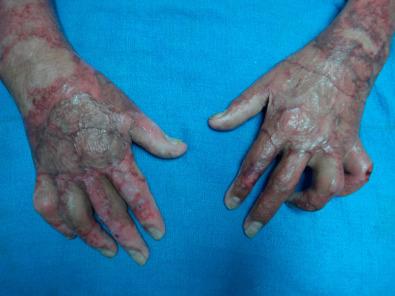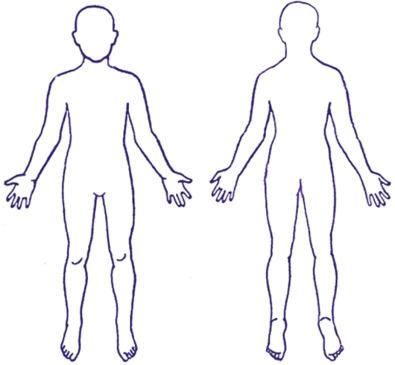Physical Address
304 North Cardinal St.
Dorchester Center, MA 02124
Surgery most commonly performed for post-burn injuries includes initial excision of non-viable tissue and, later, release of scars, correction of joint contractures, and use of grafts and flaps to resurface areas of skin loss. Common areas include the neck, axilla, elbow, wrist, hands, hips, and knees. Surgical procedures will vary depending on the skills of the surgeon, and outcomes are most critically affected by the availability of, and follow-up care by, an interdisciplinary burn team, including a skilled occupational or physical therapist. Burn therapists with an understanding of the principles and management of burns help to optimize outcomes from surgery and to facilitate patients' return to normal activities of daily living. Responsibilities of burn therapists include a thorough evaluation of the patient's history, surgical procedures performed, and assessment of physical and functional deficits. A treatment plan is then established and implemented addressing wound, edema, scar management, anti-contracture positioning, splinting, therapeutic exercises, and activities to encourage return to day-to-day activities. Successful management of burns must include the active participation of the patient and family members working together with the burn medical team.
The incidence of burns globally in 2004 was ranked fourth of all injuries sustained, with 11 million people needing medical attention in low- and middle-income countries (LMIC). The high risks for sustaining burns are largely affected by socioeconomic conditions, age, ethnicity, and gender. In LMIC, women are primarily responsible for meal preparation and commonly sustain flame burns from cooking over low, open fires or unsafe kitchen stoves; loose clothing such as the saris worn in Bangladesh and India can easily catch on fire. Because there are no protective barriers, children may sustain burns when touching flames from similar open fires, while keeping warm when sleeping, or when tipping pots of boiling water, resulting in severe scald burns.
High incidences of injury and death occur due to lack of burn prevention programs and resources. The World Health Organization (WHO) in 2008 summarized this global problem of burn injuries and outlined strategies to decrease the incidence of burns through education and also to improve the quality of burn care, standardizing resources and expanding access to local medical rehabilitation services.
With limited resources in LMIC, lack of immediate or poor-quality medical services results in delay in wound healing and the development of hypertrophic scars and contractures. Many factors contribute to the severity of these scar contractures after initial burn injuries, including location, depth, and size of the burn, excessive edema, inflammation, immobility, and lack of follow-through of treatment by the patient as well as lack of family support. Survivors face the loss of function for performing normal activities of daily living (ADLs) ( Fig. 4.11.1 ).

International resources through non-governmental organizations (NGOs) have helped intervene in this global problem with financial donations and direct services by medical volunteers. Reconstructive surgeries to correct burn deformities have been provided by many volunteers through direct services, education, and training for local medical staff. Although surgical interventions will free up scar contractures and deformities, follow-up post-operative care is vital to achieving maximal benefits from burn reconstruction. Optimal care should be provided by a multidisciplinary team including surgeons, anesthesiologists, nurses, medical physicians, dietitians, and physical and occupational therapists. These teams work to provide not only direct care but also help with modeling the effects of working together for better outcomes.
The role of the burn therapist includes taking a thorough evaluation of a patient's history, understanding surgical procedures performed, assessing physical and functional deficits, and providing a treatment plan in which therapeutic interventions are applied.
Assessment of post-operative surgical burn patients will determine optimal follow-up treatment. An in-depth and complete evaluation may not be possible at the initial encounter with a patient due to the acute injury and post-surgical precautions. As a patient's condition becomes more stable, more detailed assessments may be done. The evaluation may include, but is not limited to, the following (Also refer to Chapter 4.2 on Burn Wound Management):
History of current condition:
Age and gender, hand dominance
Cause of burn and date of injury
Total body surface area (TBSA) affected
Date and surgical procedures performed
Previous treatments and progress
Past medical history:
Medical illnesses
Previous injuries or surgeries
Social history:
Family and supports
Living environment
Occupation
Hobbies
As a patient's condition becomes more stable, assessments may be done as the patient is able to participate in testing. Therapeutic assessments may include :
ADL: Review of functional activities that the patient needs to return to everyday life.
Burn wound assessment: Objective components—location, depth, joints involved, color, texture, moisture ( Fig. 4.11.2 ).

Positioning: How does the patient hold affected structures? Does position contribute to deformity positions?
Edema: Verbal, visual, circumferential measurements (using tape measure).
Pain: Visual analog, numeric rating scale.
Range of motion (ROM): Gross visual assessment of available motion, use of goniometric measurements.
Gross/fine motor coordination: Hand dominance, ability to grasp or manipulate objects for function.
Strength: Grip or pinch strength sufficient to engage in day-to-day activities, manual muscle testing.
Sensation (needed to protect patient from further injury): Intact or loss of sensation to light touch.
Scar appearance (once wound is healed): Assessment of color, height/thickness, pliability.
Become a Clinical Tree membership for Full access and enjoy Unlimited articles
If you are a member. Log in here